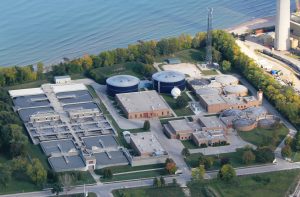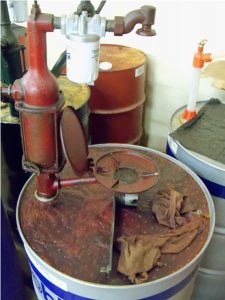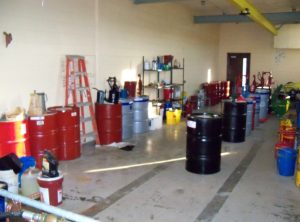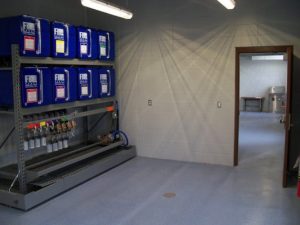Sheboygan Wastewater Treatment Plant Keeps Lubricant Clean
The WWTP saved oil room space with new lubricant storage and dispensing system.
By: Larry King, regional sales manager, The IFH Group, Inc.

The Sheboygan WWTP borders Lake Michigan, into which it discharges, and handles 2 million gallons of wastewater a day.
The Sheboygan Regional Wastewater Treatment Facility serves the cities of Sheboygan and Sheboygan Falls, WI, as well as the villages of Kohler and the towns of Lima, Sheboygan, Sheboygan Falls and Wilson. It cleans the wastewater for over 68,000 residents in seven local communities. The WWTF operates five major lift stations and an advanced treatment facility capable of treating an average of 10 million gallons per day with a peak design capacity of 58.6 million gallons per day. The facility is operated and maintained by 15 dedicated professionals who work to produce clean water that is then returned to Lake Michigan.
Wastewater passes through a series of five major treatment processes in order to remove excess nutrients and bacteria. Solids are treated by an anaerobic digestion which produces biogas. The biogas are converted into heat and electricity, enough heat and electricity to be nearly 100% self-sufficient. The digested biosolids are then dried and can be applied on land as fertilizer. The wastewater treatment processes and energy production require a very skilled staff to fine tune the intricate balance of physical, biological, and chemical processes. The Sheboygan Regional WWTF is a true Resource Recovery Facility and leader in sustainability
Lubricating the Equipment
In many cases, new oil is the dirtiest oil in the plant. The containers used to store lubricants are often reused and may be subjected to many extreme conditions before they reach your plant. Machines run better and with fewer failures if their lubricants are cleaner and have their additives intact. One of the best ways to guarantee that machines are receiving cleaner, better oil is to ensure that all lubricants are handled properly from the time they are delivered to the plant.
Many have discovered that an organized oil system pays for itself in the first two years and keeps on paying you every year that you use it. What really costs too much money is wasted time, space, oil, poor inventory control, and unsafe working conditions. A modern, mechanized oil system reduces or eliminates these problems.
In its Biosolids Dryer Project, Sheboygan has gone to a color coded system with 60 gallons in each of the 8 containers in the Model HDK 8-120107 system sourced from the IFH Group, Rock Falls, IL. via David Donahue, technical specialist- Lubrication , at distributor Application Equipment, Jackson, WI. “It includes 1 ½” Valve Arrangements for heavy viscosity oils, color coded labels and attached Quick Filter Assemblies & Grounding,” according to Donahue. It also includes a spill containment pan and sight gages for inventory control.
The IFH Fluid Storage and Dispensing System reduces the inefficient transfer of product, which can lead to safety issues, more cleanup, increased labor costs, and purchase of absorbents. Drums and pumps require tipping, cleaning, switching, and replacing. When products are not stored close to the work area, going to the product wastes time.
An effective proactive maintenance program mandates effective storage and delivery of lubricants. Protecting your lubricants, and ultimately your equipment, from the harmful effects of contamination and lubricant degradation begins with proper in-plant storage. To ensure suitable storage of lubricants, containers should be stored indoors in a dry location where temperatures remain moderate at all times. Clearly identify lubricants and machine application to avoid confusion and the misapplication of products. And, be sure that the proper transfer equipment and procedures are employed for that specific lubricant. These simple steps can substantially impact the useful life of your lubricants and your equipment.
Saving space / messy storage
“Before construction,” said Maintenance Supervisor Robert Butcher, “the size of the oil storage room was 15 Ft wide X 50 Ft long – a total of 750 Sq. Ft. It was so bad that we had to temporality move oil into the Solids building.”
Options
This left Sheboygan with a limited number of options:
• Leave the oil drums in the Solids Building (where space was needed for polymer).
• Return all used barrels and oil back into the new area. Still dirty & messy; moving barrels over floor could damage the new floor.
• Purchase a new and up to date oil containment and dispensing system. Clean, modern, up to date and safe.
“Every way we looked at it, the systems approach was the best option,” said Butcher. “It won hands down in terms of orderliness, efficient use of space and clear color labeling.”
After construction, the oil storage room was 15 ft. wide X 21 ft. long – only 315 Sq. Ft. — a loss of 58% of storage space. “It was so bad that we temporarily had to move oil into the solids building,” notes Butcher. Sheboygan had to find a way to make that up. Storage was lot more neat and clean. The IFH storage and dispensing system proved to be the answer.
If this sounds like something your company can use to manage oil, ask how we can help by calling us at (262) 238-9900 or emailing us at apemeq@appequip.com.






